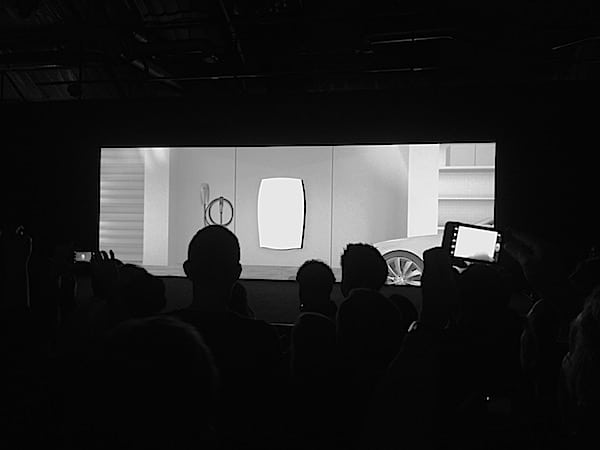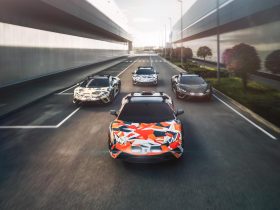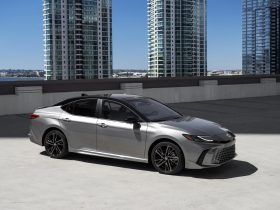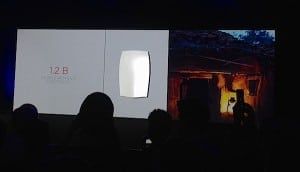 Writing about cars and covering automotive industry events is fairly easy. It has wheels, they spin and the engines are more or less the same. When electric vehicles (EV) came along, things got somewhat complicated, but nevertheless it was a breath of fresh air in an otherwise stagnant transportation world. Then came Tesla Motors, and now, with a residential and business battery system, we welcome Tesla Energy.
Writing about cars and covering automotive industry events is fairly easy. It has wheels, they spin and the engines are more or less the same. When electric vehicles (EV) came along, things got somewhat complicated, but nevertheless it was a breath of fresh air in an otherwise stagnant transportation world. Then came Tesla Motors, and now, with a residential and business battery system, we welcome Tesla Energy.
Tesla Energy Storage Releases Affordable Home Battery Solution
File it under Catch Me If You Can, we can only imagine how other carmakers must be feeling about Tesla at the moment. Although the battery storage they announced to an eager crowd last night was no surprise, it throws traditional carmaker in for a loop. What do they do with that, an affordable home battery solution.
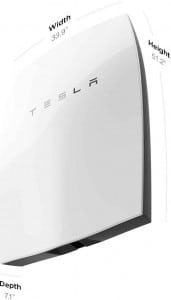 And this is where Tesla throws the entire automotive industry for a spin — again. What do you do with a technology/lifestyle company that happens to wrap its product in a gorgeous cars that can give Ferrari a run for its money? While we applaud Audi pitting it’s latest plug-in hybrid as a “Tesla killer”, it seems superficial and certainly flat compared to the many tentacles the Tesla Motors industry has grown into. And seriously, everything is a Tesla killer these days, a testimony to how well Musk brought the company from startup status to the potential game changer is became. Really, all you can offer is a car? Remember when we were warning everyine that Tesla Motors, despite the name is not a carmaker, that was years ago? Sure, it makes a car, but it is much, much more than that. So welcome Tesla Energy!
And this is where Tesla throws the entire automotive industry for a spin — again. What do you do with a technology/lifestyle company that happens to wrap its product in a gorgeous cars that can give Ferrari a run for its money? While we applaud Audi pitting it’s latest plug-in hybrid as a “Tesla killer”, it seems superficial and certainly flat compared to the many tentacles the Tesla Motors industry has grown into. And seriously, everything is a Tesla killer these days, a testimony to how well Musk brought the company from startup status to the potential game changer is became. Really, all you can offer is a car? Remember when we were warning everyine that Tesla Motors, despite the name is not a carmaker, that was years ago? Sure, it makes a car, but it is much, much more than that. So welcome Tesla Energy!
Tesla Energy Storage Adds Business & Residential Batteries
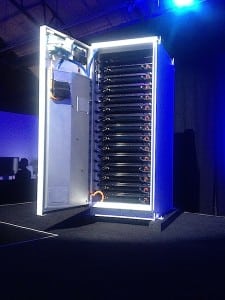 Tesla Motors announced Tesla Energy last night with much fanfare. The battery system is as sleek as you would assume coming from the company. It also surprised us when Elon Musk gave us a price, $3,500 for a 10 kWh system. And. again, if you live in California, that price comes down to roughly $1,750. In other words, Tesla flexes its muscles by giving you a battery solution for your home and business. Now you can charge at night and enjoy cheaper electricity during the day. In fact, the entire event had been powered with solar panels and the battery system it was introducing. Steps in the cousin led Solar City company that will be more than happy installing solar panel and… well, you get the idea. Welcome the Powerwall.
Tesla Motors announced Tesla Energy last night with much fanfare. The battery system is as sleek as you would assume coming from the company. It also surprised us when Elon Musk gave us a price, $3,500 for a 10 kWh system. And. again, if you live in California, that price comes down to roughly $1,750. In other words, Tesla flexes its muscles by giving you a battery solution for your home and business. Now you can charge at night and enjoy cheaper electricity during the day. In fact, the entire event had been powered with solar panels and the battery system it was introducing. Steps in the cousin led Solar City company that will be more than happy installing solar panel and… well, you get the idea. Welcome the Powerwall.
Tesla Energy Storage Introduces a Business Battery Solution
Not just happy with giving you a residential energy storage solution, the system is also available for businesses with a 1 mWh system.
Love or hate Tesla Motors, you cannot deny the company’s legendary vision and long term goals. What are they? Elon Musk is simply setting the standard blueprint for future companies, diversification, but not based on worn out and outdated financial market shares that are stagnating these days. This is about what society needs and why not make a buck while you’re at it. Come to think of it, isn’t this what America was founded upon? So pity carmakers trying to compete with a run if you can catch me company as Tesla Motors, and now Tesla Energy. How can they?
Press Release:
Tesla Energy
The world currently consumes 20 trillion kWh of energy annually.
Enough energy to power a single family home for 1.8 billion years or supply energy to a nuclear power plant for 2,300 years (or launch the Falcon 9 rocket seventeen million times).
Of all the fossil fuel consumed in the United States, one third is used in transportation and another third goes to electricity production. The US electric power sector alone produces over 2,000 million metric tons of CO2 which is like burning 225 billion gallons of gas. The EPA says it would require 1.6 billion acres of US forest to negate the environmental damage.
What if we could move the electricity grid off of fossil fuels and towards renewable energy sources?
Once we’re able to rely on renewable energy sources for our power consumption, the top 50% of the dirtiest power generation resources could retire early. We would have a cleaner, smaller, and more resilient energy grid.
Today, Tesla introduces Tesla Energy, a suite of batteries for homes, businesses, and utilities fostering a clean energy ecosystem and helping wean the world off fossil fuels.
Tesla is not just an automotive company, it’s an energy innovation company. Tesla Energy is a critical step in this mission to enable zero emission power generation.
With Tesla Energy, Tesla is amplifying its efforts to accelerate the move away from fossil fuels to a sustainable energy future with Tesla batteries, enabling homes, business, and utilities to store sustainable and renewable energy to manage power demand, provide backup power and increase grid resilience.
Tesla is already working with utilities and other renewable power partners around the world to deploy storage on the grid to improve resiliency and cleanliness of the grid as a whole.
Powerwall Home Battery
The Tesla Powerwall is a rechargeable lithium-ion battery designed to store energy at a residential level for load shifting, backup power and self-consumption of solar power generation. The Powerwall consists of Tesla’s lithium-ion battery pack, liquid thermal control system and software that receives dispatch commands from a solar inverter. The unit mounts seamlessly on a wall and is integrated with the local grid to harness excess power and give customers the flexibility to draw energy from their own reserve.
The battery can provide a number of different benefits to the customer including:
- Load shifting – The battery can provide financial savings to its owner by charging during low rate periods when demand for electricity is lower and discharging during more expensive rate periods when electricity demand is higher
- Increasing self-consumption of solar power generation – The battery can store surplus solar energy not used at the time it is generated and use that energy later when the sun is not shining
- Back-up power – Assures power in the event of an outage
The Powerwall Home Battery increases the capacity for a household’s solar consumption, while also offering backup functionality during grid outages.
The Powerwall is available in 10kWh, optimized for backup applications or 7kWh optimized for daily use applications. Both can be connected with solar or grid and both can provide backup power. The 10kWh Powerwall is optimized to provide backup when the grid goes down, providing power for your home when you need it most. When paired with solar power, the 7kWh Powerwall can be used in daily cycling to extend the environmental and cost benefits of solar into the night when sunlight is unavailable.
Tesla’s selling price to installers is $3500 for 10kWh and $3000 for 7kWh. (Price excludes inverter and installation.) Deliveries begin in late Summer.
Powerwall specs:
- Mounting: Wall Mounted Indoor/Outdoor
- Inverter: Pairs with growing list of inverters
- Energy: 7 kWh or 10 kWh
- Continuous Power: 2 kW
- Peak Power: 3.3 kW
- Round Trip Efficiency: >92%
- Operating Temperature Range: -20C (-4F) to 43C (110F)
- Warranty: 10 years
- Dimensions: H: 1300mm W: 860mm D:180mm
Highlighted Powerwall Distribution Partners
Treehouse
TreeHouse, a sustainable home improvement store, is collaborating with Tesla to sell the Powerwall home battery. “For the first time, running your home on a battery will be affordable and easy,” says TreeHouse co-founder and president Jason Ballard. “I think in the near future, having a battery in your home will be as normal as having a water heater or a dishwasher.” Ballard added, “This just takes us one step closer to being able to power homes completely without the use of fossil fuels.”
Fronius
Fronius and Tesla have partnered on a global level to offer the Tesla Powerwall in combination with the Fronius Symo Hybrid inverter as a seamless solution for residential PV systems. For new PV installations, homeowners can use the Fronius inverter to operate both the PV and the Tesla Powerwall, which reduces the overall system cost. For homeowners that already have solar PV, the Fronius inverter can be added to the system (AC coupled) or replace the existing inverter (DC coupled), and the Fronius solution will function with any type of solar energy system. This makes the Fronius plus Tesla solution a highly flexible solution across the globe.
Fronius is a leading inverter manufacturer in the global market, with nearly 1 million inverters installed worldwide. Fronius is known for both innovation and high quality, with 1,008 active patents and 23 years of solar experience. Its products are exported through 22 international Fronius subsidiaries and sales partners/representatives in over 60 countries. The company is a multi-industry leader in the fields of energy storage, battery charging, and welding technology. Fronius and Tesla are pleased to expand a current successful relationship into the realm of energy storage.
SolarEdge
SolarEdge, a leader in the global PV inverter market, and Tesla partnered for the joint development of a PV storage and backup power solution for the worldwide residential solar market. Building on SolarEdge’s proven DC optimized inverter proven and Tesla’s leading automotive-grade battery technology, the solution will require only a single SolarEdge inverter to manage both PV and storage functions. The system is designed for efficient, outdoor installation and includes remote monitoring and troubleshooting to keep operations and maintenance costs low.
Founded in 2006, SolarEdge provides an intelligent inverter solution that has changed the way power is harvested and managed in solar photovoltaic systems. The SolarEdge DC optimized inverter system maximizes power generation at the individual PV module-level while lowering the cost of energy produced by the solar PV system. Since beginning commercial shipments in 2010, SolarEdge has shipped more than 1.3 Gigawatt (‘‘GW’’) of its DC optimized inverter systems, including over 220,000 inverters, its products have been installed in PV systems in more than 73 countries, and more than 100,000 systems are monitored in its cloud-based monitoring portal.
Green Mountain Power
At Green Mountain Power we are thrilled to bring Tesla’s innovative home battery storage to Vermont as part of a radical transformation of how energy is generated and used to empower customers to save money and increase reliability and resiliency. As Vermont’s energy company of the future, we are turning the old utility model on its head, and offering products and services to help Vermonters use less energy and one day rely on the grid as a backup system. GMP is focused on a future that moves away from dirty inefficient sources of energy to a clean, sustainable and cost effective energy future. The Tesla home battery storage option will speed up the pace of change and keep Vermont on the cutting edge of innovation.”
Tesla Energy for Businesses
Based on the powertrain architecture and components of Tesla electric vehicles, Tesla energy storage systems deliver broad application compatibility and streamlined installation by integrating batteries, power electronics, thermal management and controls into a turn key system.
Tesla’s energy storage allows businesses to capture the full potential of their facility’s solar arrays by storing excess generation for later use and delivering solar power at all times. Business Storage anticipates and discharges stored power during a facility’s times of highest usage, reducing the demand charge component of the energy energy bills.
Energy storage for business is designed to:
- Maximize consumption of on-site clean power
- Avoid peak demand charges
- Buy electricity when it’s cheapest
- Get paid by utility or intermediate service providers for participating in grid services
- Back up critical business operations in the event of a power outage
Highlighted Tesla Energy Businesses
Amazon
Launched in 2006, Amazon Web Services (AWS) offers a robust, fully featured technology infrastructure platform in the cloud comprised of a broad set of compute, storage, database, analytics, application, and deployment services from data center locations in the U.S., Australia, Brazil, China, Germany, Ireland, Japan, and Singapore. More than a million customers, including fast-growing startups, large enterprises, and government agencies across 190 countries, rely on AWS services to innovate quickly, lower IT costs, and scale applications globally. To serve these customers, AWS is committed to operating in the most environmentally friendly way possible. In addition to the environmental benefits inherently associated with running applications in the cloud, AWS has a long-term commitment to achieve 100% renewable energy usage for its global infrastructure footprint. Today, three AWS Regions are 100% carbon-neutral, including US West (Oregon), EU (Frankfurt), and AWS GovCloud (US).
“We’ve been working closely with Tesla for the past year to drive innovative applications of high-capacity battery technology in data center applications with the ultimate goal of reducing the technical barriers limiting widespread adoption of renewables in the grid,” said James Hamilton, Distinguished Engineer at AWS. “Batteries are important for both data center reliability and as enablers for the efficient application of renewable power. They help bridge the gap between intermittent production, from sources like wind, and the data center’s constant power demands. We’re excited to roll out a 4.8 megawatt hour pilot of Tesla’s energy storage batteries in our US West (Northern California) Region. This complements our strategy to use renewable energy to power our global infrastructure.”
Target
“As part of Target’s support to our communities, we’re excited to partner with Tesla on a pilot test at select Target stores to incorporate Tesla Energy Storage as part of our energy strategy,” said David Hughes, senior group manager, Energy Management, Target. “Tesla’s cutting-edge technology offers unique benefits to powering these stores, most importantly relieving stress from the electrical grid at peak times, furthering Target’s investment in designing and operating energy-efficient and sustainable buildings.”
Jackson Family Wines
Jackson Family Wines (JFW) is a collection of premium and luxury wineries best known for its acclaimed Kendall-Jackson Winery. Sustainability is intentional at JFW; we have taken a two-fold approach to energy management at our wineries by improving operational efficiency across all levels of our organization and reinvesting those savings in onsite renewable energy systems.
With Tesla’s stationary energy storage solution, JFW can significantly mitigate energy use around four areas that account for the most consumption in our winemaking process: refrigeration/cooling, lighting, compressed air and process water treatment. Each battery pack will draw electricity from the grid or our onsite solar arrays during times of low demand and store it for later use to smooth out energy spikes.
EnerNoc
EnerNOC’s energy intelligence software helps customers make the most of Tesla’s energy storage systems by integrating them into an overall energy management strategy. EnerNOC’s software easily integrates with any site that has a Tesla energy storage system, optimizing battery usage during high price periods and enabling customers to utilize batteries for demand charge management and demand response.
Tesla Energy for Utility applications
For utility scale systems, 100kWh battery blocks are grouped to scale from 500kWh to 10MWh+. These systems are capable of 2hr or 4hr continuous net discharge power using grid tied bi-directional inverters.
Systems support applications including peak shaving, load shifting and demand response for commercial customers while offering, renewable firming and a variety of grid services at utility scales.
Tesla Utility Storage is designed to:
- Firm up renewable generation by reconciling the intermittency of power from these sources and storing excess capacity to dispatch when it’s needed.
- Increase resource capacity. Utility Storage acts as on-demand distributed power generation, contributing to the overall generating capacity while adding resiliency to the grid.
- Ramp Control. Utility Storage can act as a buffer while the power output from a large generation source is ramping up or down, delivering power instantly to smoothly transition output to the required level.
- Improve power quality by preventing fluctuations from propagating to downstream loads.
- Defer costly and time-consuming infrastructure upgrades.
- Manage peak demand by deploying power within seconds or milliseconds.
Highlighted Tesla Energy Utility Projects
Advanced Microgrid Solutions (grid resource adequacy)
“Tesla’s bold approach to advancing battery technology will change the way we build our cities forever” -Susan Kennedy, co-founder and CEO of Advanced Microgrid Solutions.
OnCor (microgrid)
Oncor realizes the electric industry is changing as well as our customers’ needs for electric service. Oncor believes the only way to prepare for customers’ future needs is with a flexible, adaptive electric grid which can only be accomplished through the use of technology like advanced meters, smart grid and electric storage. Tesla has long demonstrated its ability to be a technology leader which is why Oncor has looked to Tesla for grid-scale storage. Oncor looks forward to working with Tesla to make sure the electric grid meets all customers’ future needs.
Southern California Edison
Edison International is proud of its efforts to help create a market for battery storage systems and its work with Tesla to bring this technology to customers. Southern California Edison (SCE), the regulated utility subsidiary of Edison International, has developed the nation’s largest battery storage system and has contracts in place for an additional 264 megawatts of storage, including projects using Tesla batteries. SCE is working with Tesla on three demonstration projects that can help drive down the cost of battery storage systems for residential and business customers, as well as EV drivers. These demand response demonstration projects will test communication capabilities and explore rebates to customers who allow SCE to manage their battery charging in order to increase the use of renewable energy while ensuring continued grid reliability.
SoCore Energy, a subsidiary of Edison Energy, which is Edison International’s portfolio of competitive businesses and equity interests in emerging companies, is working with a client to design and install Tesla batteries at two of their retail properties in Southern California. The sites will feature Tesla battery units that will be charged with electricity from the grid during nonpeak hours at night. The two battery systems will be able to store up to 400 kilowatts and 600 kilowatts, respectively. SoCore Energy is working with its client to identify additional locations for potential battery installations. SoCore Energy is not the same company as Southern California Edison, the utility, and SoCore Energy is not regulated by the California Public Utilities Commission.
AES (solar paired at a utility level)
Tesla Motors’ commitment to battery production will help meet the growing demand for energy storage; as a launch partner, we are particularly pleased to leverage the home battery product across our distributed energy platforms. AES has been providing grid-scale energy storage solutions for seven years, building on more than 30 years of experience serving utilities with power solutions that improve lives.The AES Advancion™ digital control system for energy storage manages best-in-class batteries and other components for both centralized and distributed storage systems. In addition, AES’ world-class capability in engineering, installation and operations and maintenance enable turnkey energy storage solutions from KWs to hundreds of MW for utilities and end customers.


